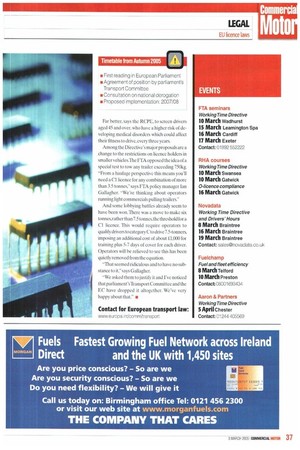Chips with everything
Page 38

Page 39

If you've noticed an error in this article please click here to report it so we can fix it.
New EU driving licence regulations could
require a microchip and increased HGV medical checks. Adam Hill reports.
This autumn the European Parliament will debate plans for a new pan-European driving licence. The Freight Transport Association estimates 110 types of licence are in use across the Continent so harmonising them seems to make sense.
The third Driving Licence Directive could see paper licences exchanged for plastic photocards containing microchips. At present paper licences are still issued with photocards in the UK. If the new proposal is endorsed it should end 'driver licence tourism', when someone banned from driving in France can come to the UK and take a test here.
Penalties and endorsements would count wherever you were and this information could be contained on the card.
Protection against fraud is a key part of the new Directive. However, the plan to allow member states to insert microchips containing additional information on the card holder is contentious — not least because no-one has any idea what it might mean in practice. The proposed Directive does not say who will be able to access the chip or what will be on it, and there is no indication of how the proposals will address the issue of data protection. Information on the chip could be updated as required,possibly including biometric information such as fingerprint or iris recognition.
Rights — and wrongs
The Department for Transport acknowledges that civil liberties, practicality and cost concerns have been raised about the chip. From an anti-fraud perspective the licence will only work if there is effective communication between member states, for example. And since none of the proposals in the new Directive are retrospective, all measures will only apply to licences issued after it comes into force, which is scheduled for 2007/08.
Bob Monks, general-secretary of the United Road Transport Union, is worried about the prospect of a microchip with potentially unlimited information on it. But he has a more general concern too:-It's like the 48-hour week. The problem is the major fudge that takes place with Directives where you end up with half a dozen variations in different countries."
The UK government is already expected to be granted at least one derogation. For vocational licence holders the new Directive proposes a medical examination at licence renewal — which means every five years up to the age of 65 and annually thereafter. Currently, UK hauliers are required to take regular medical checks from the age of 45, but five yearly medical exams for drivers under 45 would be a new requirement in the UK.
However, in its response to the Directive the Royal College of Physicians of Edinburgh (RCPE) pointed out that few relevant medical conditions are likely to be detected during routine medical checks on younger drivers, so the proposal is "unlikely to be productive or cost-effective". Doctors would find their workloads increasing without necessarily improving road safety, says the RCPE — and the Royal Society for the Prevention of Accidents agrees: "We are not aware of any evidence to suggest that extending these checks to drivers under the age of 45 years would provide road safety benefits," it concludes. Far better, says the RCPE, to screen drivers aged 45 and over, who have a higher risk of developing medical disorders which could affect their fitness to drive, every three years.
Among the Directive's major proposals are a change to the restrictions on licence holders in smaller vehicles.The FTA opposed the idea of a special test to tow any trailer exceeding 750kg. "From a haulage perspective this means you'll need a Cl licence for any combination of more than 3.5 tonnes," says FTA policy manager Ian Gallagher. "We're thinking about operators running light commercials pulling trailers."
And some lobbying battles already seem to have been won. There was a move to make six tonn es,rather than 7.5 tonnes,the threshold for a C I licence. This would require operators to qualify drivers to category C to drive 7.5-tonners, imposing an additional cost of about i1,000 for training plus 5-7 days of cover for each driver. Operators will be relieved to see this has been quietly removed from the equation.
-That seemed ridiculous and to have no substance to it." says Gallagher.
-We asked them to justify it and I've noticed that parliament'sTransport Committee and the EC have dropped it altogether. We've very happy about that." • Contact for European transport law:
www.euroca.inticommitransport










































































































































































































